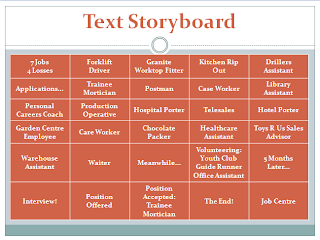Creating ideas is one of the most, if not the most, important part of a visual communicator's creative process. Ideational fluency can be described as ideas that fulfill certain requirements, it focus' more on the quantity and range of ideas rather than the quality of ideas. There are three main ways in which to think up these ideas, these are:
- Brainstorming
- Classification
- Mind Mapping
Classification consists of organised ideas whereby you recognise both the obvious and hidden denominators. Brainstorming is a way in which you can develop spontaneous thinking, this means the generation of more ideas. Mind mapping is more about the recall of ideas, it is an organised thought process that develops as a network, this produces an encouragement in associations between different thoughts.
Personally my preferred method of generating ideas is brainstorming, I find that if I sit down in a quiet place, this helps me to think properly and to get my ideas down onto paper and to generate more. Another way in which helps me to brainstorm is to talk to others about the main theme, this helps me to feed off of others thoughts and because everybody has different thought processes and ways of thinking, I find it really interesting to see how other people think and feel about the same thing as you, it generates so many different styles and ideas.
The above images are examples of my own ways of brainstorming, they show two sides of how I work, one being quite messy and thorough, and another being quite simple and orderly. I prefer to start off my brainstorm in a messy, unorganized way and to then organize it and make my ideas more neat and refined.
Getting Rid Of Assumptions
One problem with being a visual communicator is that you may start to think in the same ways, its good to keep an open mind with new ideas, these restraints can come in the form of education, rationality and experience. These restraints can have negative impacts on work which causes you to become more inhibited and it causes you to get into more of a routine, what you need is a fresh perspective that comes with each brief.
A way to keep these perspectives fresh is to look at things through similes, metaphors and analagies, these provide new ways of thinking by creating associations between objects that are different, another good thing about this method of thinking is that anything in your memory can trigger these thoughts.
The above images are examples of my own ways of brainstorming, they show two sides of how I work, one being quite messy and thorough, and another being quite simple and orderly. I prefer to start off my brainstorm in a messy, unorganized way and to then organize it and make my ideas more neat and refined.
Getting Rid Of Assumptions
One problem with being a visual communicator is that you may start to think in the same ways, its good to keep an open mind with new ideas, these restraints can come in the form of education, rationality and experience. These restraints can have negative impacts on work which causes you to become more inhibited and it causes you to get into more of a routine, what you need is a fresh perspective that comes with each brief.
A way to keep these perspectives fresh is to look at things through similes, metaphors and analagies, these provide new ways of thinking by creating associations between objects that are different, another good thing about this method of thinking is that anything in your memory can trigger these thoughts.






